Table 1.
List of phytocannabinoids with their structures, Ki, and key findings.
| Name | Structure | Ki/µM | Key Findings |
|---|---|---|---|
| Δ9-trans-Tetrahydrocannabinol |
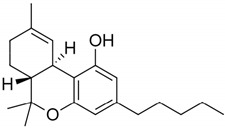
|
CB1—0.005 a 0.008 b 0.013 c CB2—0.003 a 0.0017 b 0.0068 c [45] |
THC inhibits Alzheimer’s disease (AD) pathology (by competitively inhibiting acetylcholinesterase enzyme and beta-amyloid (Aβ) peptide aggregation) [49] As analgesic for neuropathic pain [50,51] Bronchodialator effect on asthma patients [52] Effective to treat intractable cholestatic pruritus [53] Potent against methicillin-resistant Staphylococcus aureus (MRSA) strains (MIC- 2 µg/mL) * [54] Inhibit the proliferation of a hyper-proliferating human keratinocyte cell line in the treatment of psoriasis [55] |
| Δ9-Tetrahydrocannabivarin |
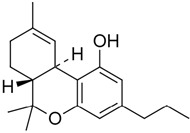
|
CB1—0.075 d 0.0047 e CB2—0.225 a 0.145 a [45] |
Exerts antiepileptiform and anticonvulsant properties in adult rats [56] Ameliorates insulin sensitivity and can be used to treat obesity-associated glucose intolerance [57] Δ8-Tetrahydrocannabivarin has potent anti-nicotine effects [58] Potent against MRSA strains (MIC—4 µg/mL) * [54] As a potential therapeutic benefit for the management of obesity and diabetes [59] |
| Cannabinol |
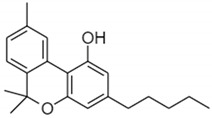
|
CB1—0.069 f 0.012 g CB2—0.016 g 0.07 f [45] |
Potent against MRSA strains (MIC—2 µg/mL) * [54] Inhibit the proliferation of a hyper-proliferating human keratinocyte cell line in the treatment of psoriasis [55] |
| Cannabidiol |
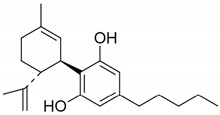
|
CB1—4.3 e 1.45 g CB2—2.86 f 0.37 g [45] |
Potent against MRSA strains (MIC—2 µg/mL) * [54] Inhibit the proliferation of a hyper-proliferating human keratinocyte cell line in the treatment of psoriasis [55] Potent inhibitor of transporter ABCC1 or MRP1 that helps in accumulation of anticancer drugs in cells [60] Protect against Aβ neurotoxicity in AD [61] Inhibits tau hyperphosphorylation in AD [62] Anti-arthritic by targeting synovial fibroblasts [63,64] Fluorinated derivatives of cannabidiol shows therapeutic activity as anxiolytic, antidepressant, antipsychotic, and anticompulsive [65] Prevents post-ischemic injury via HMGB1-inhibiting mechanism [66] |
| Cannabidivarin |
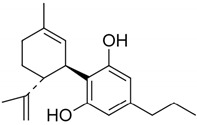
|
CB1—14.7 g CB2—0.57 g [45] |
Ameliorates autism-like behaviours, restores endocannabinoid signaling and neuroinflammation [67] Anti-convulsant [68] Potent against MRSA strains (MIC—8 µg/mL) * [54] |
| Cannabigerol |

|
CB1—0.896 g CB2—0.153 g [45] |
Anti-oxidant properties in macrophages [69] Can be used to treat inflammatory bowel disease [70] Potent anti-inflammatory agent in a model of multiple sclerosis (MS) [71] Cannabigerol derivative VCE-003.2 protects against mutant huntingtin-induced neurodegeneration [72] Cannabigerol derivative VCE-003 can be used in the treatment of human immune diseases [73] Potent against MRSA strains (MIC—2 µg/mL) * [54] Plays a neuroprotective role in the treatment of Huntington’s disease (HD) [74] |
| Cannabichromene |

|
CB1—0.71 g CB2—0.256 g [45] |
Potent against MRSA strains (MIC—8 µg/mL) * [54] Inhibit the proliferation of a hyper-proliferating human keratinocyte cell line in the treatment of psoriasis [55] Anti-inflammatory properties [75] |
MIC-Minimum Inhibitory Concentration; * Antibacterial Activity against MRSA USA300; Ki-inhibitory constant. a Assay—[3H]CP55-940 binding assay; Cell type-CHO cell membrane/Human. b Assay—[3H]CP55-940 binding assay; Cell type-CHO cell membrane/Mouse. c Assay—[3H]CP55-940 binding assay; Cell type-CHO cell membrane/Rat. d Assay—[3H]CP55-940 binding assay; Cell type-Whole-brain membranes/Mouse. e Assay—[3H]CP55-940 binding assay; Cell type-Cortical brain membranes/Rat. f Assay—[3H]CP55-940 binding assay; Cell type-CHO cell/Human. g Assay—[3H]CP55-940 binding assay; Cell type-Sf9 cells/Human.
